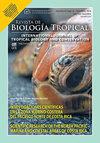Dispersion of seeds at night and day in sub-Andean forests, Cueva Los Guacharos Park, Colombia
IF 0.6
4区 生物学
Q4 BIOLOGY
引用次数: 0
Abstract
Introduction: Much has been argued about the importance of the role that different types of frugivores play as seed dispersers in plant communities, but few studies have been actually carried out. Objective: We evaluated and compared diurnal and nocturnal seed dispersal in a primary and secondary sub-Andean forest in Southern Colombia. Methods: We estimated number and biomass (kg/ha) of seeds dispersed over one year (2017) using 60 fruit traps that were checked before sunrise and before sunset for 10 continuous days every two months. Results: We found that from 1 874 dispersed seeds, 55.8 % (10.9 kg/ha) were collected during the day and 44.2 % (6.39 kg/ha) at night. There were no significant differences between diurnal and nocturnal seed dispersal in number of seeds or biomass. We also found no difference in between seed dispersal that in the primary forest and secondary forest over time. Within diurnal organisms, primates and fruit-eating birds appear to be primarily responsible for this ecosystem service during the day; while bats, birds (e.g. oilbirds), and probably primates did so during the night. Conclusions: Diurnal and nocturnal dispersal seem to be equal in terms of number and weight of seeds, but not in the similarity of dispersed plant species. It remains a challenge to recognize the relative importance of different fruit-eating organisms as seed dispersers using fruit trap methods.哥伦比亚Cueva Los Guacharos公园安第斯山脉下森林的种子昼夜分散
引言:关于不同类型的食草动物在植物群落中作为种子传播者的作用的重要性,人们争论不休,但实际进行的研究很少。目的:我们评估并比较了哥伦比亚南部安第斯山脉初级和次级森林中种子的昼夜传播情况。方法:我们使用每两个月在日出前和日落前连续10天检查的60个果实捕捉器,估计了一年(2017年)内分散的种子数量和生物量(kg/ha)。结果:从1874粒分散种子中,白天收集55.8%(10.9kg/ha),夜间收集44.2%(6.39kg/ha)。日间和夜间种子传播在种子数量或生物量方面没有显著差异。我们还发现,随着时间的推移,原始森林和次生林中的种子传播没有差异。在昼夜活动的生物中,灵长类动物和食果鸟类似乎主要负责白天的生态系统服务;而蝙蝠、鸟类(如油鸟),可能还有灵长类动物在夜间也会这样做。结论:从种子的数量和重量来看,昼夜传播似乎是相等的,但在分散植物物种的相似性方面却不一样。认识到不同的食果生物作为使用水果诱捕方法的种子传播者的相对重要性仍然是一个挑战。
本文章由计算机程序翻译,如有差异,请以英文原文为准。
求助全文
约1分钟内获得全文
求助全文
来源期刊

Revista De Biologia Tropical
生物-生物学
CiteScore
1.80
自引率
0.00%
发文量
23
审稿时长
4-8 weeks
期刊介绍:
The Revista de Biología Tropical / International Journal of Tropical Biology and Conservation is a mainstream scientific journal published since 1953 and covered by Web of Science; Science Citation Index; Current Contents; Google Scholar; Scopus, SciELO and nearly 50 additional indices.
A double blind system guarantees you a fair evaluation, and our world class editorial and scientific boards provides a first decision in three working days. The journal is Full Open Access and is widely read where your article can have the highest real impact.
Since its beginning in 1953, the Revista follows these principles: objective and independent evaluation of all manuscripts; transparency in all processes; ethical use of procedures, data, specimens and subjects; fair treatment of all parties; and absolute predominance of scientific rigor over any other aspect.
 求助内容:
求助内容: 应助结果提醒方式:
应助结果提醒方式:


